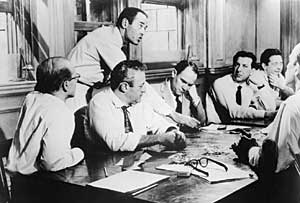“We’re talking about somebody’s life here. We can’t decide it in five minutes … We nine can’t understand how you three are still so sure. Maybe you can tell us.”
—Henry Fonda as a juror in 12 Angry Men

With just two brief quotes from this 1957 film classic, Henry Fonda’s character—an architect—begins to emerge as the leader of a group of men who are deciding a capital murder case. He is the lone dissenter initially but eventually is able to persuade the other 11 jurors to reexamine the evidence and acquit on the basis of reasonable doubt. His successful strategies for leading the group include encouraging equal and inclusive participation and taking time to deliberate slowly. He considers the various agendas of the other jurors carefully so he can understand their perspectives, proffer persuasively, and then influence the outcome.
While participating in a group’s decision about whether a person is guilty of a crime whose punishment would result in death is not a normal part of an architect’s daily routine, and integrated practice teams not normally as unruly as that jury was, architects who are capable leaders hold great power. This is particularly evident today as new project-delivery methods, technology, and sustainability are transforming practice. It is useful to consider leadership in terms of scales of influence—from mentoring an intern, leading project teams, and directing community development to formulating national policy—all of which are essential to fulfilling our role as true professionals.
In college, architects learn how to think critically and go beyond the status quo to form meaningful new ideas. This training gives them the ability to see the big picture, reframe questions to see different perspectives, create innovative solutions to problems, attend to detail, manage and reconcile diverse and complex interests and relationships. Architects who lead effectively can leverage those assets to benefit their practice, the profession, and society.
Architects have the knowledge to address challenges such as those articulated by Rob Sheehan, Jr., academic director of Executive MBA and Executive Degree programs at the Smith School of Business at the University of Maryland: “What are the next strategic steps for our firm, where should our profession go, and what do we want our community to be like?” But how do architects mobilize people to act on that knowledge? Sheehan says, “Some see the question as, ‘I know the right thing to do, now how can I learn how to interact with people so I can get them to do what I want them to do?’ ” Instead, Sheehan says the question should be, “I have some thoughts about what we should do; how can I effectively share my insights and what I care about with others while also authentically listening to their insights?” This suggests an attitude about leadership, one that requires, according to Sheehan, enough wisdom to know that someone else may have an even better idea.
Leading a practice
Ambassador Richard Swett, FAIA, author of Leadership by Design (2005), says, “Leadership is an essential skill that enables the architect to convincingly convey his or her vision to the client while imparting a sense of discipline, confidence, and concern for a high-quality outcome.” A firm’s leader will motivate others to follow and implement the vision with enthusiasm, says Swett, affirming conventional wisdom.
Insightful leadership can help firms gain a competitive advantage. Lately, nearly every firm has eyed the cultural changes that firms must undertake to transition to an integrated project delivery model successfully. Phil Bernstein, FAIA, vice president of AEC Industry Strategy and Relations at Autodesk, suggests such major shifts in the way firms work must begin with an acknowledgment that there are no easy answers in times of intensive innovation and redefinition of practice. He says, “Principals must have the courage to articulate a philosophy of practice that is consistent with their values as designers that reflects the new realities of an integrated approach: That design thinking now expands to include a much more holistic view of solving the owner’s problem than just design intent.”
Bernstein says that supporting experimentation “on the front lines” is one leadership strategy for firm principals to “find the best avenues to success in integrated projects.” Andrea Leers, FAIA, principal of Leers Weinzapfel Associates Architects, the AIA’s Firm of the Year for 2007, agrees with Bernstein to the extent that her staff is encouraged to push beyond the firm’s “present views.” The entire studio is engaged in frequent design and process discussions, specifically about new technologies and project management. Leers says transparency and access of the staff to leadership are important parts of creating an environment that supports the firm’s vision and mission.
Cultivating leadership from the ranks is another way to keep staff happy and challenged and sustain a firm’s well-being for the long-term. Leers’ firm achieves this by rotating administrative tasks among associates so that all have experienced most responsibilities, and gained an understanding of what it takes to run a practice in its totality.

Post a comment to this article
Report Abusive Comment